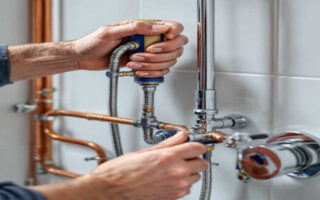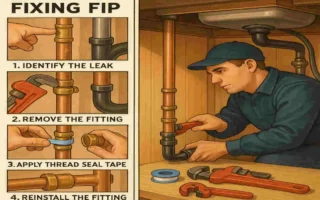Plumbing issues can be a nightmare for any homeowner. Slow drains, stubborn clogs, and recurring blockages can disrupt your daily life, creating a frustrating mess that no one wants to handle. While professional plumbing services are always an option, knowing how to handle minor clogs can save you time and money. One of the most effective tools for this job is the plumbing snake.
Understanding Plumbing Snakes
What Is a Plumbing Snake?
A drain snake or auger, is a simple yet powerful tool designed to clear clogs from household plumbing systems. Unlike a plunger, which relies on suction and pressure, a plumbing snake physically enters the pipe to break up or remove blockages.
There are two main types of plumbing snakes:
- Manual Plumbing Snakes require hand-cranking to feed the cable through the pipe.
- Electric Plumbing Snakes: These are motorized, making tackling tougher clogs or longer pipes easier.
A standard plumbing snake consists of three key components:
- Flexible Cable: A long, coiled wire that navigates through pipes.
- Auger Head: The tip of the cable that grabs or breaks up debris.
- Handle or Crank: Used to control the movement of the cable and auger.
How Does a Plumbing Snake Work?
So, how does a plumbing snake work to clear blockages? It’s a fairly straightforward process:
- Feeding the Snake: The flexible cable is inserted into the drain, allowing it to navigate bends and curves in the pipe.
- Rotating the Cable: By turning the handle or activating the motor, the auger head spins, breaking apart clogs or catching debris.
- Retracting the Cable: The cable is pulled back, often bringing the clog with it or leaving the pipe clear.
The snake’s flexibility ensures it can manoeuvre through most household plumbing systems without causing damage, making it an essential tool for DIY plumbing.
When Should You Use a Plumbing Snake?
Not every clog requires a plumbing snake. Here are some situations where it’s the best tool for the job:
- Slow Drains: When water empties longer than usual, indicating a partial blockage.
- Stubborn Clogs: When a plunger fails to dislodge debris.
- Recurring Blockages: For pipes that frequently clog due to hair, grease, or other materials.
However, there are limits. For severe clogs deep within the plumbing system or signs of structural pipe damage, it’s best to call a professional.
Preparing to Snake Your Plumbing
Safety and Preparation Checklist
Before you begin, gathering the right tools and ensuring your workspace is safe is important. Here’s what you’ll need:
- Plumbing Snake (manual or electric)
- Rubber Gloves: To protect your hands from dirt and bacteria.
- Bucket and Towels: To catch any water or debris.
- Flashlight: For better visibility.
- Protective Eyewear: To avoid splashes from dirty water.
Remove any items around the drain area to create a clear workspace.
Assessing the Problem
To use the plumbing snake effectively, you need to identify the clog’s location and type:
- Determine the Type of Drain: Is it a sink, tub, shower, or toilet?
- Evaluate Severity: Is the water completely blocked or draining slowly?
- Check the Trap: For sinks, you may need to remove the P-trap (the curved pipe beneath the sink) for better access.
Step-by-Step Guide: How to Snake a Drain
Here’s a detailed, step-by-step breakdown of how to use a plumbing snake.
Access the Drain
Remove any covers, stoppers, or strainers from the drain opening. Consider detaching the P-trap for easier entry if you’re working on a sink.
Insert the Plumbing Snake
Feed the auger end of the plumbing snake into the drain. Use slow, steady pressure to guide the cable into the pipe without forcing it.
Advance the Snake
Rotate the handle or activate the motor to extend the cable further into the pipe. This movement helps the auger navigate bends and curves, reaching the clog.
Break Up or Retrieve the Clog
Once you feel resistance (indicating a blockage), gently twist and push the snake to break up the debris. If the clog is solid, the auger tip may hook onto it, allowing you to pull it out.
Retract the Snake and Remove Debris
Slowly pull the snake back, rotating as needed to avoid snagging. Dispose of any debris properly to prevent re-clogging.
Test and Clean Up
Run water through the drain to confirm the clog is cleared. Finally, clean and dry the plumbing snake to prevent rust and ensure it’s ready for use.
Tips for Effective and Safe Use
Best Practices
Follow these tips for the best results:
- Use slow, controlled movements to avoid damaging pipes.
- Clean the snake after each use to prevent corrosion.
- Be patient; some clogs take time to dislodge.
Common Mistakes to Avoid
Avoid these pitfalls to prevent further plumbing issues:
- Using Excessive Force: This can damage pipes or the snake itself.
- Skipping Gloves: Protect your hands from sharp debris and bacteria.
- Not Testing the Drain: Always verify the clog is cleared before finishing.
Types of Plumbing Snakes and Their Uses
Here’s a handy table to help you choose the right plumbing snake for your needs:
Type of SnakeBest ForManual/ElectricTypical Length
Hand Auger Sinks, tubs, showers Manual 15–25 feet
Closet Auger Toilets Manual 3–6 feet
Drum/Electric Snake Main lines, tough clogs Electric 50+ feet
When to Choose Each Type
- Use a hand auger for smaller clogs in sinks or bathtubs.
- A closet auger is specifically designed for toilets, preventing scratches on porcelain.
- Opt for a drum or electric snake for severe clogs in main lines or long pipe systems.
Troubleshooting: What If Snaking Doesn’t Work?
Sometimes, even the best efforts don’t solve the problem. Here’s what to do next:
Signs of a Deeper Issue
- Persistent clogs even after snaking.
- Multiple fixtures are draining slowly, indicating a main line problem.
Next Steps
- Try snaking from a different access point.
- Call a professional plumber if the clog persists or if you suspect structural damage.
Preventing Future Clogs
Routine Maintenance Tips
- Clean drains regularly with non-corrosive solutions.
- Avoid flushing items like wipes, grease, and hair.
- Install drain screens to catch debris.
When to Schedule Professional Drain Cleaning
Schedule annual or biannual professional cleanings for older homes or recurring issues to keep your plumbing in shape.
You may also read (category plumbing)




